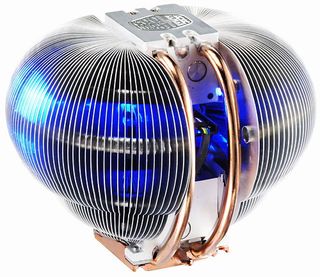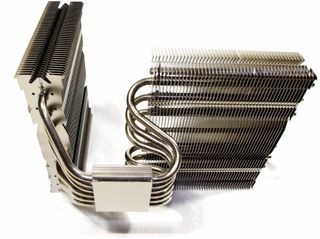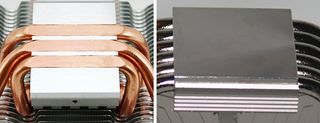How To: Properly Plan And Pick Parts For An Air-Cooled PC, Part 2
After discussing the theory of PC cooling, in Part One, we now move on to technology and implementation, discussing case fans, CPU coolers, and thermal grease. We even wrap up with a recipe you can use if you fail to cool your PC properly.
CPU Coolers: Selection And Installation
There are a great number of aftermarket CPU coolers available, and many are more capable than the boxed solutions you get with a retail processor from AMD or Intel. Don't make the mistake of assuming that they're all better, or even compatible, though. Before you pick your next heat sink and fan, ask (and then answer) the following questions:
• Does this cooler fit my processor interface?
• Is its specified cooling performance sufficient for my needs?
• Does the cooler’s air flow direction match my case?
• Does the cooler fit my case (and over my memory modules) with regard to its dimensions?
• Can the cooler be turned, if needed?
• Does the cooler come with a back plate for support (if it weighs more than a pound)?
• Does the cooler's specified noise level fit my needs?
• Does the cooler’s price make sense for this PC?
• Are benchmarks for this cooler available?

Once you've answered the important questions, then you can start considering how each potential winner looks.
Suitability And performance Always Trump A Pretty Face!
Typically, picking a cooler depends principally on the constraints of a build budget. It doesn't make sense to buy more heat sink than you need, though it's nice to keep an overclocked processor nice and cool with performance reserves. It doesn't make sense to go overboard, just like it doesn't make sense to pinch pennies and end up with stability issues. Most importantly, your cooler of choice needs to live up to its specs when it's running inside a case, in the real world. A healthy mix of solid engineering and raw airflow usually does the trick, regardless of whether you pick a tower cooler, a downward-facing blower, or some more exotic design.

Without a good fan, the best CPU cooler simply cannot live up to its potential. Some companies deliberately don't bundle their heat sinks with fans, giving the user freedom to pick the right complement. As an example, we found that the Prolimatech Super Mega combined with a PWM-controlled Noiseblocker Multiframe is ideal for running a Core i5-2500K at up to 5 GHz. At 4.5 GHz, the system whispers at a barely-measurable 22 dB(A).
Massive Base Or Exposed Heat Pipes?
Stay on the Cutting Edge
Join the experts who read Tom's Hardware for the inside track on enthusiast PC tech news — and have for over 25 years. We'll send breaking news and in-depth reviews of CPUs, GPUs, AI, maker hardware and more straight to your inbox.
This seems to be a question shrouded in marketing. Many high-end coolers (like Prolimatech) have a massive base plate and no flattened heat pipes. Xigmatek's products, however, do. They feature the cryptically-named D.L.H.D.T. (Double Layer with Heat-pipe Direct Touch) technology, and seemingly derive no real advantage from it. We think that other criteria are more important in choosing a cooler.

Seating the Cooler
Using the right amount of pressure is essential. The more-is-better approach doesn't work here because you don't want to warp your motherboard and create an uneven fit. Also, don't test for correct cooler placement by turning it, as doing this may rupture the thin layer of thermal paste. Instead, fasten the screws until you feel resistance, and then take a look at the CPU temperature in the BIOS. If that number is in the safe zone, odds are good that the cooler is properly mounted.
Ease Of Installation Instead of Knotted Fingers
As with any other piece of hardware, it makes sense to do your research before buying. Browse cooler reviews for a model that's easy enough to install if you're worried about the complexity of an enthusiast-oriented product. And don't be afraid to take to the forums for help from our community of power users.
Current page: CPU Coolers: Selection And Installation
Prev Page Case Fans: Recommendations Next Page CPU Coolers: The Right Thermal Paste-
Ragnar-Kon Helpful even for myself (who has been building PCs for years). Granted all it really told me is that I was doing it right all along, but it did give me some useful bits of information that I didn't know before.Reply
Kind of disappointed that the process of aftermarket GPU cooling wasn't explained more. That is something I have never done before, but always wanted to try out on one of my older cards. -
drutort gloves? who uses gloves :P I use my finger :) I have been doing it before there was even aftermarket paste :PReply
the trick is, that i did and do twist, BUT i double check how much paste there is on the heatsink and the cpu, if there is enough I then fix it up on both ends and press the 2 together and do small twist... in fact if you have it lapped, you can twist a bit and it starts to give some resistance... IMO this tells me that access paste has distributed even and any access is gone...
This works so well that you cant separate the heatsink and cpu if you try to pull it straight off most of the time, but have to switch and move it.
How do I know it works? wouldnt be getting the results i did.. my old 720 be unlocked 4 cores and running at 3.3ghz .. I recently replaced it recently with Noctura D14 and phenom II X6, that I dialed into 4.13ghz
but then again I would say don't do this at home :P (the way I do it works good enough when using thicker pastes, such as the arctic silver 5)
***I forgot to mention that this works for those heatsinks were you have a strap and not screws... I agree that those that have high pressure through screws you probably should not move or twist... but all those heatsinks that can create a lopsided effect due to the strap, this way works very well, especially when having thermal paste on both ends, and best way is to strap it down and take it apart, examine it and then fix it up add/remove any paste and place it back on.***
For the noob this is a good enough article... -
fancygoods On page 5 the second picture the top case fan points down yet hot air comes up.Reply
Im curious although it wont have a large affect, if the CPU cooler fan would act like a puller if put on the left side whether it would hurt or help the memory temps -
ojas Really good article, and a real help. Just thought i'd chip in with what i know/have to ask....Reply
I remember reading that sleeve bearing fans should not be used horizontally, that shortens the life span of the fan and makes it noisier over time. Something to do with the fluid in the bearing. Other bearings don't have this problem.
I also remember watching a program on NatGeo on submarines. Apparently modern day subs use propellors with a large number of thin blades. This basically avoids pressure diferences between water in front of the blade (in the direction it's spinning), thus prevents excessive low pressure in the region through which a propellor has passed. This avoids small bubbles of steam from building up and then popping, causing noise.
Seeing that air is a fluid too, i wonder if a similar principal will apply to it. Of course, there wont be any air bubbles popping in air, but i'm wondering if turbulence has any role to play, since i assume more blades=less turbulence. not sure though.
dB(A) is the A-curve...what about the C-curve? That's got more bass, which may be audible as a hum...C-cure measurements seem to ba a decible or three higher than A...
If the fans are connected to the mobo, you could use SpeedFan too...
With respect to the positive pressure section:
You say it goes against natural convection. What if i set the front and side panel as intake and the rear and top fans as the exhaust? I'm assuming the PSU is bottom mounted. Would it still go against convection?
What about neutral air pressure?
If, for example, the cooler needs to be re-seated following improper installation, is it a good idea to use isopropyl alcohol (Doctor's Alcohol) to clean the CPU and heatsink?
Cooler Master fans are pretty good, their higher quality fans 120mm fans move 79 to 90 CFM, their 200mm megaflow moves about 110 CFM. In both cases, rated noise is 19 dB(A). however, no rubber screws or frame so a that's a con.
BTW there's no prob with exposed heatpipes and the Arctic Silver, is there?
-
gio2vanni86 I've been doing the whole spread the paste evenly flat onto the CPU/Cooler for almost 8 years now. I'm not a professional when it comes to this solution, nor do i have eyes of a hawk to know if i do it right all the time, the temps seem to be right. I wish you guys did a temp difference on how the paste was spread in a lot different ways to give me a point of view of if there is any difference in temps, obviously the one where you can see the writing more then likely is not effective. Great article as always, cheers!Reply -
Augray37 @ ojasReply
I'm not sure about all the other questions, but i know 90% isopropyl alcohol will work to remove thermal paste. "Goof Off" or similar products are even better. Also, i'd suggest using a coffee filter to apply the alcohol or goof off and wipe away the paste. that's what i do, works every time. -
icepick314 I read years ago that thinner the layer of thermal paste, the better.Reply
Well...not THIN as in barely there thin but just enough to make lettering opaque, not completely covered.
I thought the paste is just to fill in cracks and imperfections on the heat sink and the surface of the processor...
also any word on Zalman's heat paste that comes in liquidy paste? it comes in a small bottle with a brush like nail polish...been using that all this time... -
Branden i've sometimes moved a fan's molex wires from 12v to 5v for silence's sake, but sometime it was too much. never knew i could get 7v by crossing the 12v and 5v lines like that (and wouldn't have dared try if i'd even thought of it anyway), glad to know there's another option there!Reply -
mjmjpfaff I would have liked to seen silverstone's air penetrater fans in here. Just to see how they stack up against other fans.Reply -
chesteracorgi I think that you may have proven my case for GPU cooling being superior as a case exhaust design over the shroud design. The shroud design produces temperatures from 10-30 C above the case exhaust designs.Reply
My own experience with a GTX 470 (from PNY) with a shroud showed an idle temperature abour 45-48 C. When I modded the card with a Zalman 2000F cooler the temperatures dropped to 30 C at idle. This (delta) temperature reduction was consistant for all uses: from idle to load. Similar loads produced temperatures that were 15-20 degrees C cooler with the case exhaust method over the shroud.
Just two weeks ago I added a second GTX 470 (from Galaxy) in SLI. This model has, what is touted to be, superior cooling to the reference design. It consistantly runs about 10 C hotter than the PNY cooled by thge Zalman aftermarket cooler at idle. Because of space considerations the shroud design had to be mounted above the case exhaust GPU. When the GPU load is increased the shroud design temperatures show a increase (delta) of 15- 20 C over the case exhaust. This is expected, as the top mounted GPU is the one with the major work load.
I ordered the mesh sided side door from Corsair (600T) to provide extra ventillation from a side panel fan blowing on the GPUs. If this configuration works, I expect a 5-7 degree C in the top mounted
GPU. I will be using the 200 mm fan (from Corsair) that was modded out from the top of the case when I replaced it with two 120 mm fans (from Xigmatek).
Most Popular

